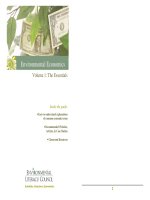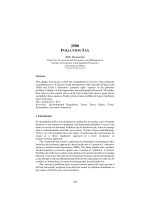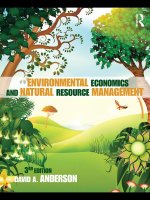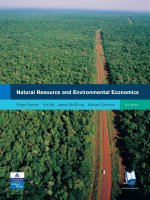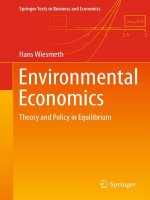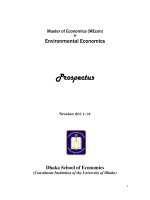Environmental economics, experimental methods
Bạn đang xem bản rút gọn của tài liệu. Xem và tải ngay bản đầy đủ của tài liệu tại đây (2.04 MB, 509 trang )
Environmental Economics,
Experimental Methods
The 1970s and 1980s saw environmental economists increasingly turn to experimental methods in an attempt to discover new ways of protecting people and
nature without wasting scarce resources in the process. Today the experimental
method is commonly applied to environmental economic questions; this book
brings together 63 leading researchers in the area and their latest work exploring
the behavioral underpinnings of experimental environmental economics.
The chapters in this volume will be illuminating for both researchers and
practitioners, specifically in relation to questions of environmental policy and
how a proposed change in incentives or benefits might affect behavior and, consequently, the likely success of a policy. This book argues that the experimental
evidence complements theoretic insights, field data and simulating models to
improve our understanding of the underlying assumptions and incentives that
drive behavioral responses to policy.
This volume covers topical areas of interest such as tradable permit markets,
common property and public goods, regulation and compliance and valuation
and preferences. Its critical advantage is that each part concludes with discussion
points written by environmental economists who do not use experimental
methods. This book will interest students and researchers engaged with environmental economics, both experimental and non-experimental and offer a unique
in-road into this field of study. Environmental policy makers will also gain
insight into behavior and decision making under alternative institutional and
policy designs.
Todd L. Cherry is the Harlan E. Boyles Professor in the Department of Economics at Appalachian State University, where he also is a research fellow at the
Appalachian Energy Center. Stephan Kroll is Professor at the Department of
Economics at California State University in Sacramento. Jason F. Shogren is
the Stroock Distinguished Professor of Natural Resource Conservation and
Management, and Professor of Economics at the University of Wyoming.
Routledge explorations in environmental economics
Edited by Nick Hanley
University of Stirling, UK
1
Greenhouse Economics
Value and ethics
Clive L. Spash
2
Oil Wealth and the Fate of Tropical Rainforests
Sven Wunder
3
The Economics of Climate Change
Edited by Anthony D. Owen and Nick Hanley
4
Alternatives for Environmental Valuation
Edited by Michael Getzner, Clive Spash and Sigrid Stagl
5
Environmental Sustainability
A consumption approach
Raghbendra Jha and K.V. Bhanu Murthy
6
Cost-Effective Control of Urban Smog
The significance of the Chicago cap-and-trade approach
Richard F. Kosobud, Houston H. Stokes, Carol D. Tallarico
and Brian L. Scott
7
Ecological Economics and Industrial Ecology
Jakub Kronenberg
8
Environmental Economics, Experimental Methods
Edited by Todd L. Cherry, Stephan Kroll and Jason F. Shogren
Environmental Economics,
Experimental Methods
Edited by Todd L. Cherry,
Stephan Kroll, and Jason F. Shogren
First published 2008
by Routledge
2 Park Square, Milton Park, Abingdon, Oxon OX14 4RN
Simultaneously published in the USA and Canada
by Routledge
270 Madison Ave, New York, NY 10016
This edition published in the Taylor & Francis e-Library, 2007.
“To purchase your own copy of this or any of Taylor & Francis or Routledge’s
collection of thousands of eBooks please go to www.eBookstore.tandf.co.uk.”
Routledge is an imprint of the Taylor & Francis Group, an informa business
© 2008 Selection and editorial matter, Todd L. Cherry, Stephan Kroll and
Jason F. Shogren; individual chapters, the contributors
All rights reserved. No part of this book may be reprinted or reproduced or
utilized in any form or by any electronic, mechanical, or other means, now
known or hereafter invented, including photocopying and recording, or in
any information storage or retrieval system, without permission in writing
from the publishers.
British Library Cataloguing in Publication Data
A catalogue record for this book is available from the British Library
Library of Congress Cataloguing in Publication Data
A catalog record for this book has been requested
ISBN 0-203-93536-5 Master e-book ISBN
ISBN10: 0-415-77072-6 (hbk)
ISBN10: 0-203-93536-5 (ebk)
ISBN13: 978-0-415-77072-9 (hbk)
ISBN13: 978-0-203-93536-1 (ebk)
Contents
List of figures
List of tables
List of contributors
ix
xii
xvi
Foreword
xix
VERNON L. SMITH
Introduction
1
TODD L. CHERRY, STEPHAN KROLL, AND JASON F. SHOGREN
PART I
Tradable permit markets
1 Baseline-and-credit emission permit trading:
experimental evidence under variable output capacity
7
9
NEIL J. BUCKLEY, STUART MESTELMAN, AND
R. ANDREW MULLER
2 A laboratory analysis of industry consolidation and
diffusion under tradable fishing allowance management
29
CHRISTOPHER M. ANDERSON, MATTHEW A. FREEMAN,
AND JON G. SUTINEN
3 Caveat emptor Kyoto: comparing buyer and seller liability in
carbon emission trading
47
ROBERT GODBY AND JASON F. SHOGREN
4 A test bed experiment for water and salinity rights trading
in irrigation regions of the Murray Darling Basin, Australia
CHARLOTTE DUKE, LATA GANGADHARAN, AND
TIMOTHY N. CASON
77
vi Contents
5 Aligning policy and real world settings: an experimental
economics approach to designing and testing a cap-and-trade
salinity credit policy
100
JOHN R. WARD, JEFFERY CONNOR, AND JOHN TISDELL
6 Discussion: tradable permit markets
131
DALLAS BURTRAW AND DAN SHAWHAN
PART II
Common property and public goods
7 Communication and the extraction of natural renewable
resources with threshold externalities
141
143
C. MÓNICA CAPRA AND TOMOMI TANAKA
8 Unilateral emissions abatement: an experiment
157
BODO STURM AND JOACHIM WEIMANN
9 Voluntary contributions with multiple public goods
184
TODD L. CHERRY AND DAVID L. DICKINSON
10 Can public goods experiments inform policy? Interpreting
results in the presence of confused subjects
194
STEPHEN J. COTTEN, PAUL J. FERRARO, AND
CHRISTIAN A. VOSSLER
11 Spies and swords: behavior in environments with costly
monitoring and sanctioning
212
ROB MOIR
12 Discussion: common property and public goods
234
CATHERINE L. KLING
PART III
Regulation and compliance
241
13 Managerial incentives for compliance with environmental
information disclosure programs
243
MARY F. EVANS, SCOTT M. GILPATRIC, MICHAEL MCKEE,
AND CHRISTIAN A. VOSSLER
14 An investigation of voluntary discovery and disclosure of
environmental violations using laboratory experiments
JAMES J. MURPHY AND JOHN K. STRANLUND
261
Contents vii
15 Congestion pricing and welfare: an entry experiment
280
LISA R. ANDERSON, CHARLES A. HOLT, AND DAVID
REILEY
16 Social preferences in the face of regulatory change
293
J. GREGORY GEORGE, LAURIE T. JOHNSON, AND
E. ELISABET RUTSTRÖM
17 The effects of recommended play on compliance with
ambient pollution instruments
307
ROBERT J. OXOBY AND JOHN SPRAGGON
18 Discussion: regulation and compliance
324
KATHLEEN SEGERSON
PART IV
Valuation and preferences
329
19 Preference reversal asymmetries in a static choice setting
331
TIMOTHY HAAB AND BRIAN ROE
20 Measuring preferences for genetically modified food products
344
CHARLES NOUSSAIR, STEPHANE ROBIN, AND
BERNARD RUFFIEUX
21 An experimental investigation of choice under “hard”
uncertainty
366
CALVIN BLACKWELL, THERESE GRIJALVA, AND
ROBERT P. BERRENS
22 Rationality spillovers in Yellowstone
383
CHAD SETTLE, TODD L. CHERRY, AND
JASON F. SHOGREN
23 Wind hazard risk perception: an experimental test
395
BRADLEY T. EWING, JAMIE B. KRUSE, AND
MARK A. THOMPSON
24 Consequentiality and demand revelation in double referenda
KATHERINE S. CARSON, SUSAN M. CHILTON, AND
W. GEORGE HUTCHINSON
407
viii Contents
25 Investigating the characteristics of stated preferences for
reducing the impacts of air pollution: a contingent valuation
experiment
424
IAN J. BATEMAN, MICHAEL P. CAMERON, AND
ANTREAS TSOUMAS
26 Forecasting hypothetical bias: a tale of two calibrations
447
F. BAILEY NORWOOD, JAYSON L. LUSK, AND
TRACY BOYER
27 Discussion: valuation and preferences
466
JOHN C. WHITEHEAD
Index
476
Figures
1.1
1.2
1.3
1.4
1.5
1.6
1.7
1.8
1.9
1.10
2.1
2.2
2.3
2.4
2.5
2.6
3.1
3.2
3.3
3.4
3.5
3.6
3.7
4.1
4.2
4.3
4.4
4.5
4.6
4.7
4.8
4.9
Firm cost curves
Sequence of events in a typical period
Cap-and-trade equilibrium
Baseline-and-credit equilibrium
Capacity
Output volume
Aggregate emissions
Efficiency
Permit trading prices
Aggregate permit inventory
Profit functions for operators
Diffusion treatment prices with an initial lease period
Consolidation treatment prices with an initial lease period
Average efficiency in the diffusion treatment
Average efficiency in the consolidation treatment
Percentage of market shares held by large and medium–large
operators
Session procedure
Efficiency and emission outcomes by treatment
Mean aggregate buyer production by treatment
Mean aggregate seller production by treatment
Mean permit prices by treatment
Mean trades by treatment
Efficiency and emission outcomes by treatment
The Sunraysia irrigation districts and salinity impact zones
Market demand and supply for water
Transaction price in the water market, treatment 1
Transaction price in the water market, treatment 2
Transaction price in the water market, treatment 3
Transaction quantity in the water market, treatment 1
Transaction quantity in the water market, treatment 2
Transaction quantity in the water market, treatment 3
Transaction price in the salt market, treatment 2
12
13
18
19
22
22
23
23
25
26
35
37
37
39
40
41
56
59
60
61
61
68
72
79
83
87
88
88
89
89
90
91
x
Figures
4.10
4.11
4.12
5.1
5.2
5.3
5.4
5.5
5.6
7.1
7.2
7.3
7.4
7.5
8.1
8.2
8.3
8.4
8.5
8.6
8.7
9.1
9.2
9.3
9.4
10.1
10.2
11.1
11.2
11.3
11.4
15.1
15.2
15.3
Transaction price in the salt market, treatment 3
Transaction quantity in the salt market, treatment 2
Transaction quantity in the salt market, treatment 3
Schematic of the hydrogeology of irrigation water quality
affected by variable upper catchment salt loads
Observed aggregate recharge in the discriminant and uniform
price tender treatments
Observed and predicted bids for the uniform tender treatment
Observed and predicted bids for the discriminant tender treatment
Aggregate farm income, including gains from trade, observed
in the open and closed call market treatments
Recharge units traded in the 70 percent reduction, uniform price,
social payment and communication treatments
Production functions
Average resource amount
Resource stock and number of subjects with relevant messages
in each period and horizon
Resource stock and number of subjects with relevant messages
in each period and horizon
Resource stock and number of subjects with relevant messages
in each period and horizon
Abatement per period
Scatterplots for seq-treatments
Abatement over periods
Alpha
Individual behavior of country 1 and j
Profit per period
Classification of 36 groups in the sequential treatments
MPCR by group account for multiple heterogeneous treatment
Total contributions to group accounts by treatment
Group contributions across homogeneous competing group
accounts
Group contribution across heterogeneous competing group
accounts
GHL application, comparison of all-human and virtual-player
contributions
Ferraro and Vossler (2005) experiment, mean contributions
Aggregate CPR appropriations by treatment
Gross efficiency gain over Nash by treatment
Net efficiency gain over Nash by treatment
Group monitoring levels by treatment
Benefits and costs of the risky route
An entry game session with 60 rounds (me070804)
Predicted and observed distributions of entry outcomes for a
session with 60 rounds (me070804)
91
92
92
103
117
119
119
121
123
147–8
149
151
152
152
166–7
167
170–1
172
172
174–5
177
189
189
190
191
203
206
220
221
222
225
283
285
286
Figures xi
15.4
15.5
15.6
16.1
17.1
17.2
17.3
17.4
17.5
17.6
17.7
19.1
20.l
20.2
21. l
21.2
22.1
23.1
23.2
24.1
Entry game with $2 entry fee (me062904)
Entry game with information about other entrants (me071504)
Entry game with voting on entry fee (me063004)
Distributions of bids for the alternative solutions
Mean group totals by treatment and period, tax/subsidy
instrument
Mean group totals by treatment and period, tax instrument
Mean efficiency by treatment and period, tax/subsidy
instrument
Mean efficiency by treatment and period, tax instrument
Mean decision by subject type and period, tax/subsidy
instrument
Distributions of individual decisions, by treatment, tax/subsidy
Distributions of individual decisions, by treatment, tax
Between-subject comparison: experiment 1 post-treatment
preferences for tasks (by treatment)
Average bids for the four biscuits in each period of GMO phase,
experiment 1
Average bids for the two identical chocolate bars in periods 1–3,
experiment 2
Basic decision tree
Histogram of participant criteria selection for scenarios 1–3
Preference reversal rates
Subject predictions on failure by shingle loss and building
breach (modular and manufactured test specimens)
Certainty equivalents for incorrect and correct answers
Schematic of the design of the double referendum experiments
286
288
289
301
313
313
314
314
317
318
319–20
337
355
358
370
375
390
401
404
410
Tables
1.1
1.2
1.3
1.4
1.5
2.1
2.2
2.3
3.1
3.2
3.3
3.4
3.5
3.6
3.7
3.8
3.9
4.1
4.2
4.3
4.4
4.5
5.1
5.2
5.3
5.4
7.1
Cost parameters
Variable capacity predictions
Equilibrium surplus efficiency
Mean values over periods 6 to 9 by treatment
Mean efficiency over periods 6 to 9
Market share holdings for operators
First-order autoregressive model of average prices in asset
rounds 5 and 6
Two-way random effects regression of market share
consolidation
Experimental design
Experiment conditions and producer costs
Experiment results by treatment
Buyer mean production choices (periods 6–8)
Seller mean production choices (periods 6–8)
Session mean price results (periods 6–8)
Estimated regression results (p-values in parentheses)
Experiment results by treatment: additional sessions
Overproduction-to-total sales ratio
Parameter ranges from Sunraysia
Private redemption and cost values
Experimental design
Model equilibrium predictions
Random effects estimation models for average transaction
price in the water market
Decision set, farm income, crop mix and recharge of two of 12
experimental farms
ANOVA of discriminant and uniform price tender auction
treatments
ANOVA of closed and open call market treatments
ANOVA of 70 percent reduction, uniform price, social payment
and communication tender treatments
Parameters of the model
18
18
20
21
24
34
38
43
52
55
63
64
65
66
67
69
71
82
82
86
86
94
111
118
121
123
145
Tables xiii
7.2 Number of periods per horizon
7.3 Random effects GLS estimation of the effects of communication
on the levels of resource stock
8.1 Cost and benefit functions
8.2 Experimental treatments
8.3 Summary of parameters, abatements, profits, and payments
8.4 Regression analysis
8.5 Efficiency index
9.1 Experimental design
9.2 Individual contributions: two-way fixed effect estimates
10.1 GHL application, all-human treatment results
10.2 GHL application, virtual-player treatment results
10.3 GHL application, estimated logit equilibrium models
10.4 Ferraro et al. (2003) VCM experiment, mean contributions
11.1 Group contribution predictions
11.2 Summary data
11.3 Within treatment comparisons
11.4 Across treatment comparisons
13.1 Potential cheating and non-compliance cases
13.2 Design parameters by treatment
13.3 Observed cheating in experiments
13.4 Probit model results
14.1 Experimental design
14.2 Sequence of treatments using a Latin Square
14.3 Mean violation probabilities, expected numbers of violations,
and expected numbers of enforcement actions
15.1 Payoff for the risky route
15.2 Variances of entry rates in the first ten rounds, by view treatment
15.a.1 Sessions, treatments, and data averages
16.1 Per period activity table for stage one
16.2a Typical distribution options in stage two
16.2b Selected distributions for one-stage experiment
16.3a Characteristics of subject pool from each experiment: treatment
characterization (N = 168), stage 1 and stage 2 results
16.3b Characteristics of subject pool from each experiment:
demographic questionnaire responses
16.4 Regression results
17.1 Mean aggregate decision numbers by treatment
17.2 Mean aggregate decision numbers, under the tax/subsidy by
treatment
17.3 Mean aggregate decision numbers, under the tax by treatment
19.l Anchor treatments for experiment 1
19.2 Post-treatment preferences by treatment
19.3 Probit results on within-subject preference reversals,
experiment 1
146
154
161
161
162
168
175
187
190
201
202
203
206
219
221
223
224
248
253
254
255
268
270
271
282
288
291
296
297
298
299
300
302
312
315
316
335
336
338
xiv Tables
19.4 Probit results on within-subject preference reversals,
experiment 2
20.1 Sequence of events in GMO phase of an experimental session,
experiment 1
20.2 Deviations of bids from valuation, induced value phase of both
experiments
21.1 Regret analysis
21.2 Outcomes for treatment 1
21.3 Outcomes for treatment 2
21.4 Participants’ selections for scenarios 1–3
21.5 Variable definitions and descriptive statistics
21.6 Multinomial logit model 1
21.7 Multinomial logit model 2
22.1 Familiarity of participants to the lake trout introduction
22.2 Participants’ perceptions of the seriousness of the lake trout
introduction
22.3 Participants’ preference for fish
22.4 Percentage of participants affected by seeing attractions of the
park
22.5 Logit regression results for preference reversals
23.1 Descriptive statistics certainty equivalents and accuracy
24.1 Predicted and observed vote distributions – inconsequential
double referendum
24.2 Demand revealing predictions and observed vote distributions –
consequential double referendum treatments
24.3 Chi-squared p-values for differences in vote distributions in
inconsequential double referendum and consequential double
referendum treatments, by subject type
24.4 Levels and rates of non-demand revealing voting
24.5 Chi-squared p-values for tests of differences between rates of
non-demand revelation in the inconsequential double
referendum and consequential double referendum treatments
24.6 Chi-squared p-values for tests of differences between vote
distributions, conditioned on first vote outcome
25.1 Experimental design and subsample structure
25.2 Socio-economic and demographic profile of subsamples
25.3 Descriptive WTP statistics by subsample and scheme
25.4 Significance of differences in WTP values for schemes
25.5 Mean and median WTP (£) for three air pollution impact
reduction schemes, by five treatments
25.6 Treatment effects
25.7 Comparing stated WTP for Scheme A with values calculated
from stepwise first responses for Scheme H and Scheme P
26.1 Descriptive statistics of experiment
340
353
359
372
372
373
374
376
377
377
385
386
386
387
392
403
411
416
417
417
417
418
432
433
435
436
438
440
441
456
Tables xv
26.2 Relationship between certainty question, hypothetical bid
residuals, and hypothetical bias
26.3 Stochastic frontier estimation
26.a.1 Written answers to question
457
460
462–3
Contributors
Christopher M. Anderson, University of Rhode Island, Rhode Island, USA.
Lisa R. Anderson, College of William and Mary, Virginia, USA.
Ian J. Bateman, University of East Anglia, Norwich, UK.
Robert P. Berrens, University of New Mexico, New Mexico, USA.
Calvin Blackwell, College of Charleston, South Carolina, USA.
Tracy Boyer, Oklahoma State University, Oklahoma, USA.
Neil J. Buckley, York University, Toronto, Canada.
Dallas Burtraw, Resources for the Future, Washington, DC, USA.
Michael P. Cameron, University of Waikato, Hamilton, New Zealand.
C. Mónica Capra, Emory University, Georgia, USA.
Katherine S. Carson, United States Air Force Academy, Colorado, USA.
Timothy N. Cason, Purdue University, Indiana, USA.
Todd L. Cherry, Appalachian State University, North Carolina, USA.
Susan M. Chilton, University of Newcastle upon Tyne, Newcastle upon
Tyne, UK.
Jeffery Connor, CSIRO, Policy and Economic Research Unit, Australia.
Stephen J. Cotten, University of Tennessee, Tennessee, USA.
David L. Dickinson, Appalachian State University, North Carolina, USA.
Charlotte Duke, University of Melbourne, Victoria, Australia.
Mary F. Evans, University of Tennessee, Tennessee, USA.
Bradley T. Ewing, Texas Tech University, Texas, USA.
Paul J. Ferraro, Georgia State University, Georgia, USA.
Contributors xvii
Matthew A. Freeman, University of Rhode Island, Rhode Island, USA.
Lata Gangadharan, University of Melbourne, Victoria, Australia.
J. Gregory George, Macon State College, Georgia, USA.
Scott M. Gilpatric, University of Tennessee, Tennessee, USA.
Robert Godby, University of Wyoming, Wyoming, USA.
Therese Grijalva, Weber State University, Utah, USA.
Timothy Haab, Ohio State University, Ohio, USA.
Charles A. Holt, University of Virginia, Virginia, USA.
W. George Hutchinson, Queen’s University, Belfast, UK.
Laurie T. Johnson, University of Denver, Colorado, USA.
Catherine L. Kling, Iowa State University, Iowa, USA.
Jamie B. Kruse, East Carolina University, North Carolina, USA.
Stephan Kroll, California State University, California, USA.
Jayson L. Lusk, Oklahoma State University, Oklahoma, USA.
Michael McKee, Appalachian State University, North Carolina, USA.
Stuart Mestelman, McMaster University, Hamilton, Ontario, Canada.
Rob Moir, University of New Brunswick, New Brunswick, Canada.
R. Andrew Muller, McMaster University, Hamilton, Ontario, Canada.
James J. Murphy, University of Alaska, Anchorage, USA.
F. Bailey Norwood, Oklahoma State University, Oklahoma, USA.
Charles Noussair, Tilburg University, Tilburg, the Netherlands.
Robert J. Oxoby, University of Calgary, Alberta, Canada.
Stephane Robin, Université Louis-Pasteur, Strasbourg, France.
David Reiley, University of Arizona, Arizona, USA.
Brian Roe, Ohio State University, Ohio, USA.
Bernard Ruffieux, Institut National de la Recherche Agronomique, Grenoble,
France.
E. Elisabet Rutström, University of Central Florida, Florida, USA.
Kathleen Segerson, University of Connecticut, Connecticut, USA.
Chad Settle, University of Tulsa, Oklahoma, USA.
xviii Contributors
Dan Shawhan, Cornell University, New York, USA.
Jason F. Shogren, University of Wyoming, Wyoming, USA.
John Spraggon, University of Massachusetts, Massachusetts, USA.
John K. Stranlund, University of Massachusetts, Massachusetts, USA.
Bodo Sturm, Centre for European Economic Research (ZEW), Mannheim,
Germany.
Jon G. Sutinen, University of Rhode Island, Kingston, Rhode Island, USA.
Tomomi Tanaka, Arizona State University, Arizona, USA.
Mark A. Thompson, University of Arkansas, Little Rock, Arkansas, USA.
John Tisdell, Griffith University, Queensland, Australia.
Antreas Tsoumas, University of the Aegean, Mytilene, Greece.
Christian A. Vossler, University of Tennessee, Tennessee, USA.
John R. Ward, CSIRO, Policy and Economic Research Unit, Australia.
Joachim Weimann, Otto von Guericke University Magdeburg, Magdeburg,
Germany.
John C. Whitehead, Appalachian State University, North Carolina, USA.
Foreword
Public goods theory and its allied “tragedy of the commons” began on a deeply pessimistic note 40–50 years ago with the contributions of Samuelson (1954) and
Hardin (1968). The prevailing wisdom emphasized the impossibility of the private
provision of goods whose outcomes were common across all users. Pre-dating
Hardin was the less flashy and not well known but classic paper by Gordon (1954),
on fisheries, which emphasized that where there was a resource management failure
it was useful to think of the problem as one of property rights failure. Indeed, that
was the conceptual key to finding solutions; also that almost all such resources
users were, or potentially were, excludable if you could just find the way.
This insight was reinforced by Acheson’s (1975) study of the Maine lobstermen who created home-grown privately enforced property rights in the open
lobster sea beds off the coast of Maine. By the 1970s, however, main stream economics thought and taught that public goods could not be produced efficiently by
private means. Samuelson and Hardin had swept the field. But a key contribution
to inducing an about-face in the thinking of economists came from Coase (1976)
on lighthouses. The canonical example of a pure public good, and of the impossibility “theorem” in the private provision of public goods, was the lighthouse, emitting signals that all ships could observe at zero marginal cost. This dramatized the
concept of market failure. But Coase in effect asked, “I wonder how the early light
houses came about and who financed them?” As it turned out lighthouses were
privately financed before economics had become a well defined profession, let
alone developed its tools for a theory of public goods. The problem of supplying
incentives for private investments and aborting free riders was solved very practically by lighthouse owners who contracted with port authorities to charge docking
ships for lighthouse services. These “incentive” contracts allowed the capital cost
of lighthouses to be prorated among ship dockings. All ships have to dock somewhere, use lighthouses on the way, and these dockings provided an effective and
practical measure of lighthouse service utilization and value in consumption. The
theoretical argument that for “efficiency” the so-called “fixed” cost once incurred
should not affect the price of lighthouse services was a fallacious non-starter
because it omits the inefficiency that results if the lighthouse is not built! Docks,
lighthouses and ships all value lighthouse services and the contracts uncovered by
Coase had focused their mutual interest on a solution to this public goods problem.
xx
Foreword
And the famous “tragedy of the commons” in grazing cattle was not
necessarily a tragedy, at least since AD 1224 for the high Alpine Swiss cheese
makers who each summer pastured their cows on the commons: entry to summer
pastures was controlled by a property right rule that “no citizen could send more
cows to the alp than he could feed during the winter” (Netting 1976, p. 139).
These economic design problems were solved by people completely unschooled
in free rider theory, but experienced enough in their behavioral coordination
problem to seek solutions that might work. Somehow they perfected them by
trial and error “natural experiments” over time.
The reader will have noticed by now that 1976 was a good year.
Moreover, the solution that Coase found people had used to build lighthouses
was actually based on the same principle used in the Swiss Alps, namely, and
I will make my point by paraphrasing Netting, “no shipping company could pass
more of its ships past the lighthouse than it paid for as part of ship docking
charges.” The rights to a common were tied to a corollary privatized right.
Theory had enabled us to see that these were examples of excludable public
goods, and in all such cases the question is whether there are feasible ways of
limiting use to avoid or internalize external costs, or assuring payments that
cover investment cost. The solutions, as in the examples by Netting and Coase,
are often ingenious beyond the imagination of the first pencil and paper theories
whose primary value was in enabling us to see why there is and were problems
that needed solution, but which alone could not facilitate a solution. The imagination had to range beyond the mathematics of incentive failure. Equally important, one badly needed an empirical testing ground for exposing new models and
ways of thinking to tests of effectiveness.
Experimental economics responded positively and effectively to this challenge beginning in the 1970s and 1980s when the Samuelson problem of public
goods was addressed, along with the Gordon–Hardin problem of managing
common property resources. I won’t belabor that story or its literature. You will
find it in this book and my Papers in Experimental Economics (1991). That
early fledgling literature has grown into an imposing contribution collected in
this book on how to model, test bed, perfect and apply human ingenuity to the
creation of incentives that make the solutions to these problems possible. Public
goods theory will never be the same. We now think differently, more openly and
positively on these issues.
This exciting collection of research papers provides a compendium of practical
earthy rule-governed examples – fisheries management, emission abatement,
water markets, salinity control, congestion control and related measurement and
monitoring issues – all in the ancient problem solving spirit of the Alpine Swiss
cheese makers and the entrepreneurs who believed lighthouses could be provided
privately and did it. As Hayek, puts it, “Rules alone can unite and extend order.”
Enjoy!
Vernon L. Smith
Arlington, VA
Foreword xxi
References
Acheson, J.M. 1975. “The lobster fiefs: economic and ecological effects of territoriality
in the Maine lobster industry.” Human Ecology 3 (3), 183–207.
Coase, R.H. 1976. Adam Smith’s View of Man, Selected Papers No. 50, Graduate School
of Business, University of Chicago (Mont Pelerin Society, St. Andrews, 1–33).
Gordon, H. Scott. 1954. “The economic theory of a common-property resource: the
fishery.” Journal of Political Economy 62 (2), 124–42.
Hardin, Garrett. 1968. “The tragedy of the commons.” Science 162: 1243–8.
Netting, Robert. 1976. “What Alpine peasants have in common: observations on communal tenure in a Swiss village.” Human Ecology 4 (2), 135–46.
Samuelson, P.A. 1954. “The pure theory of public expenditure.” Review of Economics
and Statistics 36 (4) (November), 387–9.
Smith, Vernon L. 1991. Papers in Experimental Economics, Cambridge: Cambridge University Press.
Introduction
Todd L. Cherry, Stephan Kroll and Jason F. Shogren
Greater environmental protection at fewer costs – few people would disagree
with the idea that environmental policy should be trying to achieve this wideranging goal. How to identify and implement the strategies that can move people
toward this goal falls within the purview of environmental economics. Over the
last five decades, researchers in environmental economics have discovered and
created new methods and tools aimed at protecting people and nature without
wasting scarce resources in the process. These economists and policy makers,
with the input of researchers in other disciplines like biology, forestry and
hydrology, have taken a pragmatic approach to their task, pursuing what works
rather than preconceived mindsets.
Such pragmatism led to a natural progression for researchers in environmental economics – they quickly adopted the methods of the newly emerging area of
experimental economics in the 1970s and 1980s. As Cathy Kling points out in
Chapter 12 of this volume, “some of the earliest work in experimental economics was done by environmental economists.” Economists like Peter Bohm, Jack
Knetsch, Ron Cummings, Charles Plott, Vernon Smith, William Schulze, Don
Coursey, Elizabeth Hoffman, Jeff Bennett, and Michael McKee turned to laboratory experiments to test the efficacy of alternative mechanisms to provide
public goods efficiently and voluntarily, to understand how people value gains
and losses of a good or service, and to explore how well Pigovian taxes work
relative to Coasean bargaining solutions to resolve externality problems. Today,
we have come full circle, and the experimental method is commonly applied to
environmental economic questions, as evidenced by the research in this book
and in the general economics literature.
A reader might be asking him- or herself whether such small-scale experiments are the appropriate tool to test large-scale environmental policy. We all
know environmental protection is more complex than any laboratory or field
study. Lay people and policy makers must make decisions within a mix of biotic
and abiotic phenomena combined with social institutions like markets and nonmarket allocation systems. Do the attempts to use the experimental method to
understand better the micromotives that underpin the theory of environmental
economics have anything to say about the efficiency and fairness of global environmental policy?
2
T.L. Cherry et al.
Yes, it does, would be our answer. The lessons learned by experimental
economists can help guide environmental policy by providing insights into
how a proposed change in incentives or benefits might affect behavior and, consequently, the likely success of a policy. By supplying information on the
behavioral link between incentives, values, and choice, experiments might
affect how policy is formed and evaluated. Since the laboratory environment
differs from the wilds by necessity, experimental data used to back stated positions of policy should be viewed as support for or against a specific case of a
more general phenomenon or theory. Experimental evidence complements theoretical insight, field data, and simulation models to improve our understanding
of the underlying assumptions and incentives that drive behavioral responses to
policy.1
Experiments have proven to be a useful tool to stress-test theory, look for
empirical patterns of behavior, and test bed new institutions designed to protect
nature. First, researchers use experiments to test the predictive power of a
theory, to test the robustness of the axioms underlying the theory, to test the specific boundaries of a general theory, and to measure the gradient of behavioral
change. See, for example, the huge body of experimental research on contributions to public goods.
Second, economists use the lab to look for patterns of behavior, to identify
and measure breakdowns from rationality, to examine how contextual frames
affect behavior, to determine reactions to new information, and to consider how
people coordinate actions voluntarily and under duress. For example, the long
debate on the divergence between willingness to pay and willingness to accept
has been rejuvenated by experimental research (e.g. see Shogren 2006).
Third, laboratory experiments are used as a test bed for institutional design –
the construction of new institutions, markets, and mechanisms designed to
improve resource allocation. For example, Cason and Plott (1996) examined in a
laboratory environment the incentives for sellers in new emission trading mechanisms proposed by the US Environmental Protection Agency (see the overview
on incentive design in Bohm 2003).
This volume brings together 63 leading researchers and their latest work
exploring the behavioral underpinnings of environmental economics using experimental economic methods. Some of these researchers are environmental economists who occasionally employ experimental methods, others are experimental
economists who use their research method in different subfields of economics,
one of which happens to be environmental economics. We divide the 24 chapters
into four topical parts that cover the range of ongoing research today – tradable
permit markets, common property and public goods, regulation and compliance,
and valuation and preferences. Each part concludes with a discussion chapter.
The audience for this volume is as diverse as the authors are – we hope both
experimental economists who want to conduct policy-relevant work, and environmental economists unfamiliar with experimental methods will find useful
information and ideas for future research (experimental and non-experimental)
here. To bridge the gap between experimental methods and non-experimental
